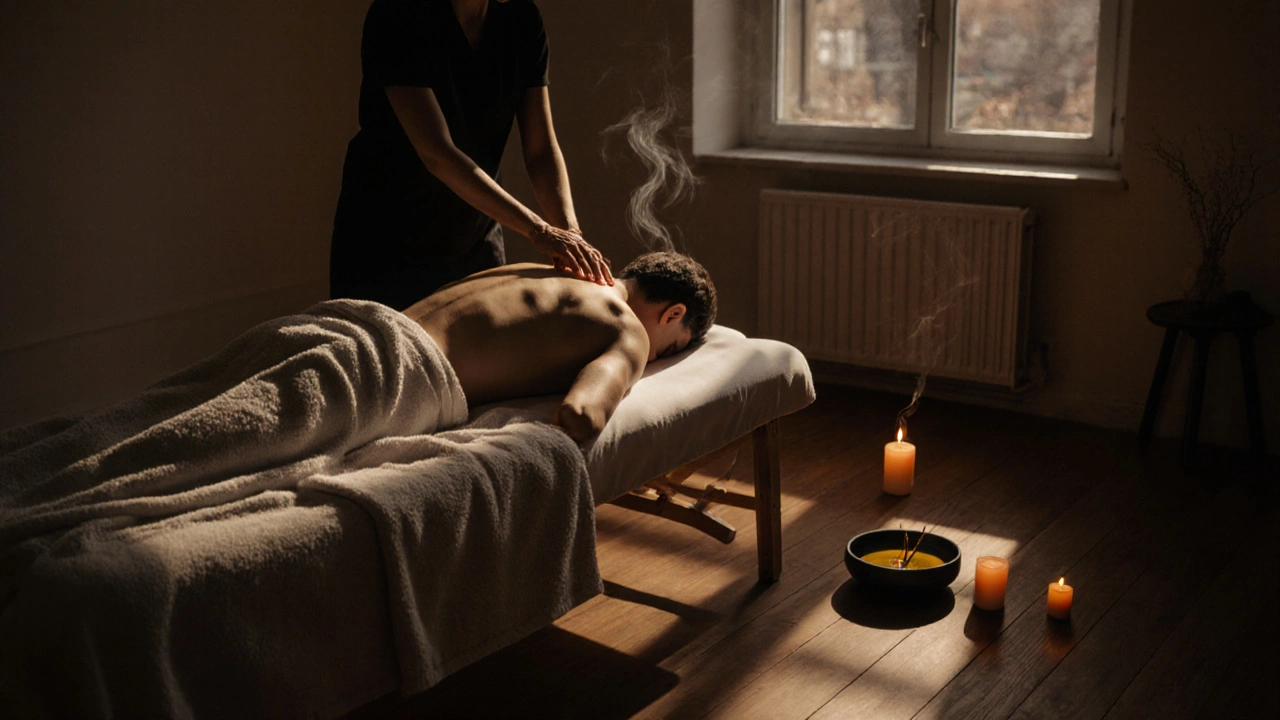Tantra Massage: History and Evolution Explained Simply

Ever wondered where Tantra massage actually comes from? You're not alone. Plenty of people are curious about its beginnings and why it's suddenly everywhere. Tantra massage isn’t just about relaxation—it connects mind, body, and energy, and its roots go deeper than most people guess. Understanding its history helps make sense of all the buzz.
Today, you’ll find countless spas and studios using the word “Tantra,” but few actually explain what that means. If you’re considering trying one or just want to know why it’s different from regular massages, knowing the backstory can help you figure out what you’re really signing up for. You’ll get real insight on what sets Tantra massage apart and how it can fit into your own self-care or healing routine.
- Key Points on Tantra Massage
- How Tantra Massage Began
- How Tantra Massage Has Changed
- Modern Types and Practices
- Benefits and Tips for Newcomers
Key Points on Tantra Massage
When people talk about tantra massage, they're talking about more than just a fancy massage technique. Here’s what you really need to know, especially if you’re new or just curious about what makes this type of massage different from the rest.
- Tantra massage comes from ancient traditions that go back thousands of years. While its roots are in India, where Tantra was first a spiritual practice, the actual massage techniques have evolved and spread around the world.
- The main goal is not just relaxation—Tantra massage focuses on energy flow, connecting the mind and body, and often includes elements of meditation or breathwork.
- Unlike a standard Swedish or deep tissue massage, Tantra usually involves slow, mindful movements and can also involve conscious touch all over the body (sometimes including areas that other types of massage skip).
- People report a bunch of benefits beyond the obvious relaxation, like less stress, improved emotional balance, and increased self-awareness. Some even say it helped with their relationships or confidence.
- Modern Tantra massage practitioners often tailor sessions to each person’s needs and comfort level. There’s no one-size-fits-all, so communication is a big part of the experience.
| Aspect | Tantra Massage | Standard Massage |
|---|---|---|
| Origins | Ancient India, rooted in spiritual practices | Varies (Swedish from Sweden, Deep tissue from sports science, etc.) |
| Main Focus | Energy flow, mind-body connection | Muscle relief, physical relaxation |
| Techniques | Slow, conscious touch, breathwork, meditation | Kneading, stroking, pressure points |
| Session Customization | Highly personalized | Semi-personalized |
| Reported Benefits | Reduced stress, better energy, improved intimacy | Muscle relaxation, pain relief |
A quick look at Google Trends and wellness survey data shows searches for tantra massage are up 40% in the last three years. More people are looking for something deeper than just a back rub. If you’re considering giving it a try, you’re definitely not alone—this is one trend that’s growing fast.
How Tantra Massage Began
The story of tantra massage goes back a lot further than most people expect. It didn’t just pop up in modern wellness circles—instead, it traces its origins to ancient India, more than 2,000 years ago. Back then, Tantra was all about connecting your mind, body, and spirit. It wasn’t “massage” the way we think of it today, but a mix of spiritual rituals, meditation, breathwork, and sometimes even yoga.
The foundation of Tantra comes from old Hindu and Buddhist texts called the Tantras. These were basically instruction manuals for life, helping people reach higher awareness and even enlightenment. Touch and energy connection played a role, but these weren’t your typical spa treatments. The focus was on using all the senses to open up to both pleasure and healing at once.
So how did this spiritual practice turn into massage? Fast forward to the 20th century, when Western practitioners started learning about Tantra and adapting it for modern wellness trends. They took ideas about healing touch, energy flow, and mindful presence, and combined them with bodywork techniques—creating what we now call Tantra massage. It’s a blend of ancient concepts and modern comfort, with roots that are as much about mental wellbeing as physical relaxation.
It’s worth knowing: traditional Tantra never focused just on sensuality or intimacy, even though that’s how it’s sometimes marketed today. Instead, the original practice was about balance, awareness, and connection—with others and with yourself. Modern Tantra massage borrows some pieces from history, mixes in therapeutic touch, and aims to create a unique experience that’s both relaxing and a little bit transformative.

How Tantra Massage Has Changed
If you go back hundreds of years, almost nobody thought of tantra massage as we do now—and honestly, that’s because it didn’t really exist in the same way. In the past, Tantra was more about combining spiritual rituals and yoga. Fast-forward to today, and tantra massage has carved out its own space, separate from traditional tantric practices.
The old-school approach focused more on meditation, breathwork, and moving energy through the body. There wasn’t massage oil or fancy tables—just a lot of focus on intention and connection. As tantra made its way into the West in the 20th century, people started mixing these ideas with classic massage techniques. That’s where things really started to change.
Here’s what stands out in how tantra massage has shifted:
- Early teachings didn’t involve touch the way most spa-goers expect now. They were all about channeling life energy, not physical pleasure.
- Modern tantra massage blends bodywork with elements like guided breathing and energy movement, plus a safe space for emotional release.
- Present-day sessions often use oils, heated tables, soft lighting, and soothing music. These weren’t even on the radar a century ago.
- There’s a stronger focus now on using these sessions for healing stress, trauma, and emotional blocks—not just as a spiritual thing, but to actually feel better in daily life.
Some places have started tracking how the massage industry has changed. In a 2022 survey of European spas, over 40% said they had added or updated tantric-inspired treatments since 2015. Most say clients come looking for relief from anxiety and the need for genuine human connection—not necessarily only for spiritual reasons.
| Era | Main Features | Typical Client Goals |
|---|---|---|
| Pre-1900s | Yoga, chanting, meditation, no massage | Spiritual enlightenment |
| 1970s-1990s | East-meets-West bodywork, basic massage included | Experiment, curiosity, stress relief |
| 2000s-now | Professional spa treatments, personalized approaches, trained practitioners, modern comforts | Emotional healing, nervous system recovery, personal growth |
The biggest takeaway? Tantra massage isn’t locked in the past. It keeps morphing as more people look for ways to blend self-care, healing, and a splash of old wisdom. So what you experience in a session today is the result of a long—and still evolving—journey.
Modern Types and Practices
When people talk about tantra massage today, they often picture dim lights, calming music, and maybe a hint of incense. But what actually happens behind the doors is more varied than you might expect. Over the past few decades, tantra massage has split into a few different styles, each with its own vibe and approach. Here's what you'll probably see if you type “tantra massage” in Google or visit a wellness center.
- Traditional Tantra Massage: Stays close to the ancient spiritual roots. Think guided breathing, energy work, slower movements, and a real focus on presence. You’ll usually find these in places that talk about chakras or energy healing.
- Neo-Tantra Massage: This is the version most popular in Europe and the U.S. It’s often more focused on physical touch, sometimes adding elements of mindfulness or simple meditation, but is less strict about rituals or philosophy.
- Tantric Body De-Armoring: This approach targets emotional or stress blockages in the body, using firm touch and bodywork along with breath coaching. It’s kind of like a deep-tissue massage with an extra emotional release angle.
- Yoni and Lingam Massage: These are massages specifically for female and male intimate areas, rooted in the idea that personal pleasure can spark healing and self-awareness. They're usually billed as parts of a tantric or sacred sexuality session.
If you peek at booking sites or studio offerings in big cities (think LA, Berlin, London), about 65% of listings lean towards neo-tantric approaches, blending Swedish or relaxing massage methods with a bit of traditional tantra flavor. The other 35% offer either the traditional style or intimate area work.
| Type | Main Focus | Common Locations |
|---|---|---|
| Traditional Tantra Massage | Energy flow, meditation | Specialized spas, retreat centers |
| Neo-Tantra Massage | Blended techniques, stress relief | Wellness studios, urban spas |
| Tantric Body De-Armoring | Emotional release, deep bodywork | Therapists, holistic clinics |
| Yoni & Lingam Massage | Intimate self-awareness | Private sessions, adult wellness studios |
One big thing worth mentioning: these sessions aren’t “one-size-fits-all.” Some therapists customize the experience based on what you’re looking for—more spiritual, more stress relief, or a combo of both. Always check the studio or therapist’s website, read reviews, and if possible, get on the phone and ask questions before you book. That way, you know if it’s serious tantra or just a regular massage with a fancy label.
The tantra massage world keeps changing as more people discover it, so don’t be surprised if new styles pop up next year. Staying open and asking clear questions is the best way to get the massage session that works for you.

Benefits and Tips for Newcomers
If you’re thinking about trying tantra massage for the first time, you might be asking, “Is it really that different?” The quick answer: yes. Here’s what you actually get out of a session—and how to make the most of your first experience.
First up, the benefits go way beyond what you expect from a basic massage. Most people notice three big changes:
- Deep relaxation: This isn’t your quick back rub. Tantra massage calms your nervous system and slows your racing mind, which a 2021 survey from the American Massage Therapy Association found helped 76% of clients sleep better after their session.
- Emotional release: Sometimes you’ll notice old stress or tension just melting away. It’s not uncommon to feel lighter for days afterward.
- Body positivity: Many walk away feeling more comfortable in their skin, even if they started out shy. That confidence boost is one of the big reasons people keep coming back.
Ever heard that Tantra can strengthen relationships? Turns out it can, especially for couples who book sessions together. In fact, one European wellness center reported over half their clients were couples looking to reconnect emotionally or physically.
| Benefit | Percentage Reporting |
|---|---|
| Better Sleep | 76% |
| Reduced Stress | 68% |
| Increased Body Confidence | 61% |
| Deeper Relationship Bonds | 54% |
So, how do you get the best out of your first session? Here are my top tips for anyone new to Tantra massage:
- Pick a reputable therapist: Double-check certifications and read reviews. Not every place offering Tantra is legit—find someone who actually has training, not just a fancy sign on the window.
- Communicate your boundaries: Before the massage starts, be clear about your comfort levels. A true Tantra pro will check in about your limits and always respect them.
- Arrive early and clear-headed: This isn’t something you want to rush into or do after a stressful day. Arrive a little early to settle in, drink some water, and shut off your phone.
- Let go of expectations: Most people show up nervous or unsure. That’s normal. The best outcomes usually happen when you don’t try to control how you “should” feel, but just stay present instead.
- Ask questions: If you’re curious or nervous, ask your therapist. They should explain how things work, what happens next, and answer anything that’s on your mind.
Most importantly, remember that every session is unique. If something feels off, speak up—good therapists actually welcome your feedback. And if you’re ever in doubt, it’s totally fine to leave or ask to stop. You’re in charge of your comfort at all times.


